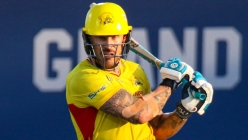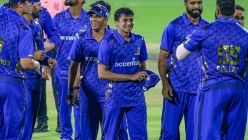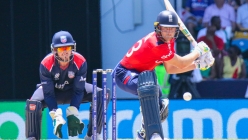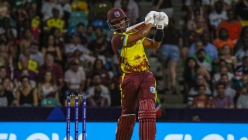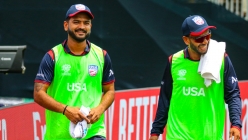Views
USA Cricket: 2021 ICC Americas Men’s T20 World Cup Qualifier Tour Report Card Part 1: Team Grades
2021 Dec 01 by DreamCricket USA
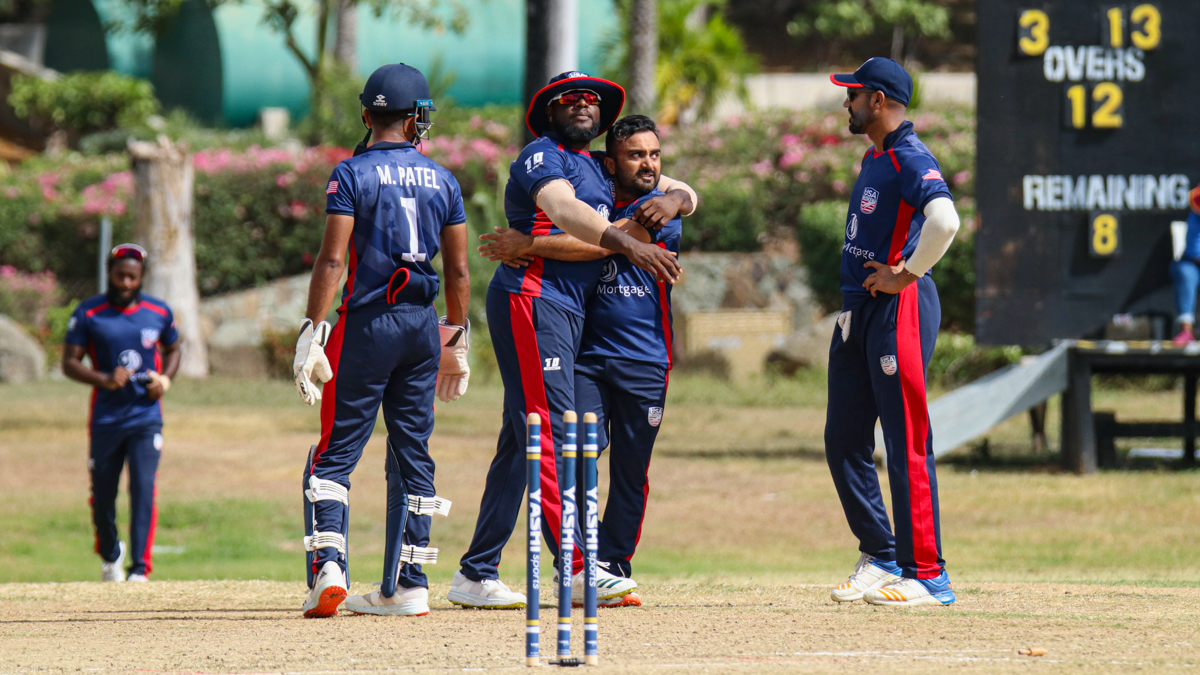
By Peter Della Penna (Twitter @PeterDellaPenna)It's the first part of USA's tour report card - team grades in five different disciplines - for their undefeated run in Antigua to claim the 2021 ICC Americas Men's T20 World Cup Qualifier title.
Image credit: Peter Della Penna
Bowling: B+
USA never bowled out any of their six opponents in Antigua. However, they also generally took wickets at regular intervals and never really allowed their opponents to get away and build partnerships. USA conceded only two half-century stands in the tournament: a 75-run third-wicket stand by Delray Rawlins and Tre Manders for the third wicket against Bermuda, and a 90-run third-wicket stand by Navneet Dhaliwal and Ravinderpal Singh against Canada. Not a single player scored a half-century against USA, with 49 by Manders being the highest individual total of the week. That’s an impressive feat on what were generally very batter-friendly wickets in Antigua.
The bowling attack production was decently balanced too. Spinners accounted for 14 wickets while pace bowlers took 25 wickets, though within that pace bowling contingent is Ian Holland who took most of his wickets with off pace deliveries bowling medium pace with Monank Patel standing up to the stumps.
In the two matches that mattered most though, the bowlers stepped up in a big way to restrict the opposition when USA’s batters faltered. The majority of the credit for USA’s undefeated tournament run deserves to go to the bowlers and that is reflected in the bowling group getting a higher grade.
Batting: B-
This group is hard to grade because on the raw numbers, USA’s unit did not produce much statistically. Nobody from USA is in the top 10 of the overall tournament scorers list, though that is mostly a function of USA batting second in five of six games, including all four of the matches against the second tier teams in the tournament field: Argentina, Bahamas, Belize and Panama. Against the latter four, USA achieved victories by eight, nine and a pair of ten-wicket wins, meaning most players never got to bat outside of the Canada and Bermuda matches. The clinical efficiency in which USA went about those four matches showcased a focused effort.
However, the batting faltered at times in the key matches against Canada and Bermuda. USA had four half-century partnerships during the event. Three of those were partnerships against the weaker teams in the tournament – an unbeaten 68-run partnership between Monank Patel and Steven Taylor against Belize, an unbroken 91-run stand by Ian Holland and Aaron Jones against Bahamas, and an unbroken 53-run third-wicket stand by Jones and Gajanand Singh against Argentina. The fourth and most important half-century stand USA had came against Bermuda when Monank and Taylor put on 53 for the first wicket. The Powerplay aggression demonstrated by the captain and USA’s most prolific T20 batsman was instrumental in victory over Bermuda, especially after the middle order stumbled badly in the final five overs.
On the other hand, the top-order failed spectacularly against Canada – highlighted by very poor shot selection by Monank and Taylor – and it took a middle and lower order rescue effort to get USA into a Super Over, where Taylor stepped up to blast USA to a winning total off the first three legal balls. But the fact that USA had six different Player of the Match winners, most of them batsmen, showcased USA’s batting depth in the event. Even though no individual had a truly standout week with the bat, somebody stepped up on each occasion when it mattered to get the team to victory.
Fielding: B
Against more skilled teams, USA may have been punished worse for some of their miscues during the week. They missed a total of 11 chances – five runouts and six chances in the air – but the misses only cost them a total of 73 runs, or an average of 6.6 runs per missed chance. On the flip side, USA’s batsmen received six letoffs and scored another 65 runs after the fact. Xavier Marshall and Aaron Jones were the chief beneficiaries of the missed chances while batting as Jones went on to finish not out on both occasions he was let off while Marshall ended 47 not out against Panama after being dropped twice, including the first time on 5. Coincidentally, both players, along with Jaskaran Malhotra, were also responsible for the majority of USA’s missed chances in the field.
It was not USA’s sharpest fielding performance in a tournament by any stretch, but there were some individual highlights, such as Ian Holland’s spectacular catch on the boundary on the opening day of the tournament. Monank Patel also performed admirably with the gloves – especially standing up to Holland’s medium pace – making a case that he could be a long-term option as a wicketkeeper rather than a stopgap one.
Fitness: C+
Ali Khan playing only three matches out of six was a signal that team management is petrified of him suffering another injury in case of overuse and so they only played him when it was deemed absolutely necessary. Elmore Hutchinson and Karima Gore also ended the tournament with what appeared to be minor injury issues. From a heat and conditions point of view in Antigua, USA made it through the six matches without any issues on the match day itself, a far cry from the early scenes when they toured Oman in September when it was clear some players arrived on tour with suboptimal fitness levels. But the durability of certain players is a concern for when the global qualifier arrives next year when teams traditionally have to play multiple sets of back-to-back matches without rest.
Tactics: A-
Rusty Theron running the two byes off the final ball against Canada was the standout moment of the tournament and the difference between USA being winners instead of runner-up to Canada. As was the case in the ODIs on the tour of Oman in September, the return of Steven Taylor to the top of the order was another hugely influential decision sparked by head coach J Arunkumar to right one of the major strategic wrongs of the last four years. Using Taylor to begin on strike for the Super Over against Canada may have been a debatable move with his earlier failure in the same match, combined with Jaskaran Malhotra having the hot hand heading into the final over of regulation. But the decision was justified when Taylor belted two sixes off his first three legal balls to put USA into a winning position.
On the bowling side, the unorthodox use of Ali Khan – traditionally a new ball bowler in T20 franchise cricket – to come on as a first change bowler against both Bermuda and Canada worked wonders for USA. Ian Holland’s usage throughout the event was also done to near perfection by captain Monank Patel. Whereas many of USA’s issues on their ill-fated tour of Bermuda two years ago were down to strategic and tactical blunders, almost every decision made on field in Antigua was followed by positive results. Huge credit goes to both J Arunkumar and Monank for steering USA to an undefeated tournament title performance.
The only blemish comes down to pre-tournament selection compared to selection while on tour. Why is a 39-year-old bowling allrounder being selected if he’s going to ride the bench for the first four matches? As has been written before on this platform, Elmore Hutchinson has been a fine servant for USA, but if he’s not going to play in the starting XI against Canada and Bermuda, why is he on tour at all? An argument could be made that he was there as an insurance policy in the event that a more experienced bowler got injured. But the reality is that Hutchinson’s spot could have gone to a young talent looking to gain experience around the USA squad to aid in their overall development down the road and not doing so was a missed opportunity.
Giving 29-year-old left-arm spinner Trinson Carmichael a tour debut ahead of Vatsal Vaghela, who is 10 years younger with equivalent output in terms of wickets in the Minor League T20 season, was a curious call at the time but grew even more questionable after Carmichael returned zero wickets while ending the tour as USA’s most expensive bowler on economy rate despite his two games coming against a pair of the weaker opponents in the tournament field, Argentina and Bahamas. Saurabh Netravalkar’s future in the T20 squad was shaky after paltry statistical returns as captain in Bermuda two years ago – taking two wickets in six matches with a 7.10 economy rate – and he did not do much to allay those concerns in Antigua, finishing with two wickets in five games with a 4.92 economy rate (fifth on the team). In the two games against Bermuda and Canada, Netravalkar returned 0 for 28 in three overs and 0 for 27 in four overs respectively.
The fact that USA refused to pick a legspinner in this format – Timil Patel was USA’s leading wicket-taker at the 2019 ICC Americas T20 Regional Final in Bermuda with nine wickets – also looks like an issue that may cost USA in the long term.
USA may have advanced to the global qualifier for the 2022 ICC T20 World Cup with an undefeated record in Antigua. But it would be surprising not to see multiple changes made when this squad takes the field against Ireland for two T20Is in December as USA builds toward trying to reach next year’s World Cup in Australia.
[Views expressed in this article are those of the author, who was present in Antigua for all six of USA's matches, and do not necessarily represent the views of DreamCricket management. If you have different views or opinions, we respect those views and urge you to provide your feedback, both positive and negative. Feel free to respond to the author via Twitter @PeterDellaPenna.]
